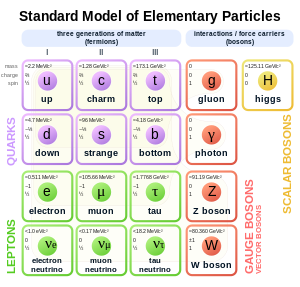Lepton

W−
boson. The
W−
boson subsequently decays into an electron and an electron antineutrino.
Leptons are a family of elementary particles, alongside quarks and gauge bosons.
Like quarks, leptons are fermions (spin-1⁄2 particles) and are subject to the electromagnetic force, the gravitational force, and weak interaction, but unlike quarks, leptons do not participate in the strong interaction.
There are six flavours of leptons, forming three generations. The first generation is the electronic leptons, comprising the electrons (
e−
) and electron neutrinos (
ν
e); the second is the muonic leptons, comprising muons (
μ−
) and muon neutrinos (
ν
μ); and the third is the tauonic leptons, comprising tauons (
τ−
) and tauon neutrinos (
ν
τ). Each lepton has a corresponding antiparticle – these antiparticles are known as antileptons.
Leptons are an important part of the Standard Model, especially the electrons which are one of the components of atoms, alongside protons and neutrons. Exotic atoms with muons and tauons instead of electrons can also be synthesized.
Etymology
| Particle name | Antiparticle name |
|---|---|
| Electron | Antielectron Positron |
| Electron neutrino | Electron antineutrino |
| Muon Mu lepton Mu |
Antimuon Antimu lepton Antimu |
| Muon neutrino Muonic neutrino Mu neutrino |
Muon antineutrino Muonic antineutrino Mu antineutrino |
| Tauon Tau lepton Tau |
Antitauon Antitau lepton Antitau |
| Tauon neutrino Tauonic neutrino Tau neutrino |
Tauon antineutrino Tauonic antineutrino Tau antineutrino |
The name lepton (from the Greek λεπτός or leptos, meaning thin) was first used by physicist Léon Rosenfeld in 1948:[1]
Following a suggestion of Prof. C. Møller, I adopt — as a pendant to "nucleon" — the denomination "lepton" (from λεπτός, small, thin, delicate) to denote a particle of small mass.
The etymology incorrectly implies that all the leptons are of small mass. When Rosenfeld named them, the only known leptons were electrons and muons, which are in fact of small mass — the mass of an electron (0.511 MeV/c2)[2] and the mass of a muon (105.7 MeV/c2)[3] are fractions of the mass of the "heavy" proton (938.3 MeV/c2).[4] However, the mass of the tauon (discovered in the mid 1970s) (1777 MeV/c2)[5] is nearly twice that of a proton, and about 3,500 times that of electrons.
History
The first lepton identified was the electron, discovered by J.J. Thomson and his team of British physicists in 1897.[6][7] Then in 1930, Wolfgang Pauli postulated the electron neutrino to preserve conservation of energy, conservation of momentum, and conservation of angular momentum in beta decay.[8] Pauli theorized that an undetected particle was carrying away the observed difference between the energy, momentum, and angular momentum of the initial and final particles. The electron neutrino was simply known as the neutrino back then, as it was not yet known that neutrinos came in different flavours (or different "generations").
Nearly 40 years after the discovery of the electron, the muon was discovered by Carl D. Anderson in 1936. Due to its mass, it was initially categorized as a meson rather than a lepton.[9] It later became clear that the muon was much more similar to the electron than other mesons, as muons do not experience the strong interaction, and so later the categories were redefined to take this into account. Electrons, muons and the (electron) neutrino were thus regrouped into a new group of particles – the leptons.[citation needed] In 1962 Leon M. Lederman, Melvin Schwartz and Jack Steinberger showed that more than one type of neutrino exists by first detecting interactions of the muon neutrino, which earned them the 1988 Nobel Prize, although by then the different flavours of neutrino had already been theorized.[10]
The tauon was first detected in a series of experiments between 1974 and 1977 by Martin Lewis Perl with his colleagues at the SLAC LBL group.[11] Like the electron and the muon, it too was expected to have an associated neutrino. The first evidence for tauon neutrinos came from the observation of missing energy and momentum in tauon decay, analogous to the missing energy and momentum in beta decay leading to the discovery of the electron neutrino. The first detection of tauon neutrino interactions was announced in 2000 by the DONUT collaboration at Fermilab, making it the latest particle of the Standard Model to have been directly observed.[12]
Although all present data is consistent with three generations of leptons, some particle physicists are searching for a fourth generation. The current lower-limit on the mass of the fourth charged lepton is 100.8 GeV/c2,[13] while its associated neutrino has a mass of at least 45.0 GeV/c2.[14]
Properties
Spin and chirality

Leptons are spin-1⁄2 particles. The spin-statistics theorem thus implies that they are fermions and thus that they are subject to the Pauli exclusion principle; no two leptons of the same species can be in exactly the same state at the same time. Furthermore, it means that a lepton can have only two possible spin states namely up or down.
A closely related property is that of chirality, which in turn is closely related a more easily visualized property called helicity. The helicity of a particle is the direction of its spin relative to its momentum; particles with spin in the same direction as their momentum are called right-handed and otherwise they are called left-handed. When a particle is massless the direction of its momentum relative to its spin is frame independent, while for massive particles it is possible to 'overtake' the particle by a Lorentz transformation flipping the helicity. Chirality is a technical property (defined through the transformation behaviour under the Poincare group) that agrees with helicity for (approximately) massless particles and is still well defined for massive particles.
In many quantum field theories—such as quantum electrodynamics and quantum chromodynamics—left and right-handed fermions are identical. However in the Standard Model left-handed and right-handed fermions are treated asymmetrically. Only left-handed fermions participate in the weak interaction, while there are no right-handed neutrinos. This is an example of parity violation. In the literature left-handed fields are often denoted by a capital L subscript (i.e.
e−
L) and right-handed fields are denoted by a capital R subscript.
Electromagnetic interaction

One of the most prominent properties of leptons is their electric charge, Q. The electric charge determines the strength of their electromagnetic interactions. It determines the strength of the electric field generated by the particle (see Coulomb's law) and how strongly the particle reacts to an external electric or magnetic field (see Lorentz force). Each generation contains one lepton with Q = −1 (conventionally the charge of a particle is expressed in units of the elementary charge) and one lepton with zero electric charge. The lepton with electric charge is commonly simply referred to as a 'charged lepton' while the neutral lepton is called a neutrino. For example the first generation consists of the electron
e−
with a negative electric charge and the electrically neutral electron neutrino
ν
e.
In the language of quantum field theory the electromagnetic interaction of the charged leptons is expressed by the fact that the particles interact with the quantum of the electromagnetic field, the photon. The Feynman diagram of the electron-photon interaction is shown on the right.
Since leptons have an intrinsic rotation in the form of their spin, charged leptons generate a magnetic field. The size of their magnetic dipole moment μ is given by,
- ,
where m is the mass of the lepton and g is the so called g-factor for the lepton. To first order approximation quantum mechanics predicts that the g-factor is 2 for all leptons. However higher order quantum effects caused by loops in Feynman diagrams introduce corrections to this value. These corrections, referred to as the anomalous magnetic dipole moment, are very sensitive to the details of a quantum field theory model and thus provide the opportunity for precision tests of the standard model. The theoretical and measured values for the electron anomalous magnetic dipole moment agree up to eight significant figures.[15]
Weak Interaction
|
In the Standard Model the left-handed charged lepton and the left-handed neutrino are arranged in doublet (
ν
eL,
e−
L) that transforms in the spinor representation (T = 1⁄2) of the weak isospin SU(2) gauge symmetry. This means that these particles are eigenstates of the isospin projection T3 with eigenvalues 1⁄2 and −1⁄2 respectively. In the meantime, the right-handed charged lepton transforms as a weak isospin scalar (T = 0) and thus does not participate in the weak interaction, while there is no right-handed neutrino at all.
The Higgs mechanism recombines the gauge fields of the weak isospin SU(2) and the weak hypercharge U(1) symmetries to three massive vector bosons (
W+
,
W−
,
Z0
) mediating the weak interaction, and one massless vector boson, the photon, responsible for the electromagnetic interaction. The electric charge Q can be calculated from the isospin projection T3 and weak hypercharge YW through the Gell-Mann–Nishijima formula,
- Q = T3 + YW/2
To recover the observed electric charges for all particles the left-handed weak isospin doublet (
ν
eL,
e−
L) must thus have YW = −1, while the right-handed isospin scalar
e−
R must have YW = −2. The interaction of the leptons with the massive weak interaction vector bosons is shown in the figure on the right.
Mass
In the Standard Model each lepton starts out with no intrinsic mass. The charged leptons (i.e. the electron, muon, and tauon) obtain an effective mass through interaction with the Higgs field, but the neutrinos remain massless. For technical reasons the masslessness of the neutrinos implies that there is no mixing of the different generations of charged leptons as there is for quarks. This is in close agreement with current experimental observations.[16]
It is however known from experiment – most prominently from observed neutrino oscillations[17] – that neutrinos do in fact have some very small mass, probably less than 2 eV/c2.[18] This implies that there are physics beyond the Standard Model. The currently most favoured extension is the so called Seesaw mechanism, which would explain both why the left-handed neutrinos are so light compared to the corresponding charged leptons, and why we have not yet seen any right-handed neutrinos.
Leptonic numbers

The members of each generation's weak isospin doublet are assigned leptonic numbers that are conserved under the Standard Model.[19] Electrons and electron neutrinos have an electronic number of Le = 1, while muons and muon neutrinos have a muonic number of Lμ = 1, while tauons and tauon neutrinos have a tauonic number of Lτ = 1. The antileptons have their respective generation's leptonic numbers of −1.
Conservation of the leptonic numbers means that the number of leptons of the same type remains the same, when particles interact. This implies that leptons and antileptons must be created in pairs of a single generation. For example, the following processes are allowed under conservation of leptonic numbers:
but not these:
However, neutrino oscillations are known to violate the conservation of the individual leptonic numbers. Such a violation is considered to be smoking gun evidence for physics beyond the Standard Model. A much stronger conservation law is the conservation of the total number of leptons (L), conserved even in the case of neutrino oscillations, but even it is still violated by a tiny amount by the chiral anomaly.
Universality
The coupling of the leptons to gauge bosons are flavour-independent (i.e., the interactions between leptons and gauge bosons are the same for all leptons).[19] This property is called lepton universality and has been tested in measurements of the tauon and muon lifetimes and of Z boson partial decay widths, particularly at the Stanford Linear Collider (SLC) and Large Electron-Positron Collider (LEP) experiments.[citation needed]
The decay rate (Γ) of muons through the process
μ−
→
e−
+
ν
e +
ν
μ is approximately given by an expression of the form (see muon decay for more details)[19]
where K1 is some constant, and GF is the Fermi coupling constant. The decay rate of tauons through the process
τ−
→
e−
+
ν
e +
ν
τ is given by an expression of the same form[19]
where K2 is some constant. Electron–muon universality implies that K1 = K2, and thus[19]
This explains why the branching ratios for the electronic mode (17.85%) and muonic (17.36%) mode of tauon decay are equal (within error).[5]
Universality also accounts for the ratio of muon and tauon lifetimes. The lifetime of a lepton (τl) is related to the decay rate by[19]
where B(x → y) and Γ(x → y) denotes the branching ratios and the resonance width of the process x → y.
The ratio of tauon and muon lifetime is thus given by[19]
Using the values of the 2008 Review of Particle Physics for the branching ratios of muons[3] and tauon[5] yields a lifetime ratio of ~1.29×10−7, comparable to the measured lifetime ratio of ~1.32×107. The difference is due to K1 and K2 not actually being constants; they depend on the mass of leptons.
Table of leptons
| Particle/Antiparticle Name | Symbol | Q (e) | S | Le | Lμ | Lτ | Mass (MeV/c2) | Lifetime (s) | Common decay |
|---|---|---|---|---|---|---|---|---|---|
| Electron / Antielectron[2] | e− / e+ |
−1/+1 | 1⁄2 | +1/−1 | 0 | 0 | 0.510998910(13) | Stable | Stable |
| Muon / Antimuon[3] | μ− / μ+ |
−1/+1 | 1⁄2 | 0 | +1/−1 | 0 | 105.6583668(38) | 2.197019(21)×10−6 | e− + ν e + ν μ |
| Tauon / Antitauon[5] | τ− / τ+ |
−1/+1 | 1⁄2 | 0 | 0 | +1/−1 | 1776.84(17) | 2.906(10)×10−13 | See τ− decay modes |
| Electron neutrino / Electron antineutrino[18] | ν e/ ν e |
0 | 1⁄2 | +1/−1 | 0 | 0 | < 0.0000022[20] | Unknown | |
| Muon neutrino / Muon antineutrino[18] | ν μ/ ν μ |
0 | 1⁄2 | 0 | +1/−1 | 0 | < 0.17[20] | Unknown | |
| Tauon neutrino / Tauon antineutrino[18] | ν τ/ ν τ |
0 | 1⁄2 | 0 | 0 | +1/−1 | < 15.5[20] | Unknown |
See also
Notes
- ^ L. Rosenfeld (1948)
- ^ a b C. Amsler et al. (2008): Particle listings –
e−
- ^ a b c C. Amsler et al. (2008): Particle listings –
μ−
- ^ C. Amsler et al. (2008): Particle listings –
p+
- ^ a b c d C. Amsler et al. (2008): Particle listings –
τ−
- ^ S. Weinberg (2003)
- ^ R. Wilson (1997)
- ^ K. Riesselmann (2007)
- ^ S.H. Neddermeyer, C.D. Anderson (1937)
- ^ I.V. Anicin (2005)
- ^ M.L. Perl et al. (1975)
- ^ K. Kodama (2001)
- ^ C. Amsler et al. (2008) Heavy Charged Leptons Searches
- ^ C. Amsler et al. (2008) Searches for Heavy Neutral Leptons
- ^ M.E. Peskin, D.V. Schroeder (1995), p. 197
- ^ M.E. Peskin, D.V. Schroeder (1995), p. 27
- ^ Y. Fukuda et al. (1998)
- ^ a b c d C.Amsler et al. (2008): Particle listings – Neutrino properties
- ^ a b c d e f g B.R. Martin, G. Shaw (1992)
- ^ a b c J. Peltoniemi, J. Sarkamo (2005)
References
- C. Amsler et al. (Particle Data Group) (2008). "Review of Particle Physics". Physics Letters B. 667: 1. doi:10.1016/j.physletb.2008.07.018.
- I.V. Anicin (2005). "The Neutrino - Its Past, Present and Future". arXiv:physics/0503172.
{{cite arXiv}}:|class=ignored (help) - Y.Fukuda; et al. (1998). "Evidence for Oscillation of Atmospheric Neutrinos". Physical Review Letters. 81: 1562–1567. doi:10.1103/PhysRevLett.81.1562. arXiv:hep-ex/9807003.
{{cite journal}}: Explicit use of et al. in:|author=(help) - K. Kodama (2001). "Observation of tau neutrino interactions". Physics Letters B. 504: 218. doi:10.1016/S0370-2693(01)00307-0.
- B.R. Martin, G. Shaw (1992). "Chapter 2 – Leptons, quarks and hadrons". Particle Physics. John Wiley & Sons. pp. 23–47. ISBN 0-471-92358-3.
- S.H. Neddermeyer, C.D. Anderson (1937). "Note on the Nature of Cosmic-Ray Particles". Physical Review. 51: 884–886. doi:10.1103/PhysRev.51.884.
- J. Peltoniemi, J. Sarkamo (2005). "Laboratory measurements and limits for neutrino properties". The Ultimate Neutrino Page. Retrieved 2008-11-07.
{{cite web}}: External link in|work= - M.L. Perl; et al. (1975). "Evidence for Anomalous Lepton Production in e+–e− Annihilation". Physical Review Letters. 35 (22): 1489–1492. doi:10.1103/PhysRevLett.35.1489.
{{cite journal}}: Explicit use of et al. in:|author=(help) - M.E. Peskin, D.V. Schroeder (1995). Introduction to Quantum Field Theory. Westview Press. ISBN 0-201-50397-2.
- K. Riesselmann (2007). "Logbook: Neutrino Invention". Symmetry Magazine. 4 (2).
- L. Rosenfeld (1948). Nuclear Forces. Interscience Publishers. p. xvii.
- R. Shankar (1994). "Chapter 2 – Rotational Invariance and Angular Momentum". Principles of Quantum Mechanics (2nd ed.). Springer. pp. 305–352. ISBN 978-0-306-44790-7.
- S. Weinberg (2003). The Discovery of Subatomic Particles. Cambridge University Press. ISBN 052182351X.
- R. Wilson (1997). Astronomy Through the Ages: The Story of the Human Attempt to Understand the Universe. CRC Press. p. 138. ISBN 0748407480.
External links
- Particle Data Group homepage. The PDG compiles authoritative information on particle properties.
- Leptons, a summary of leptons from Hyperphysics.









